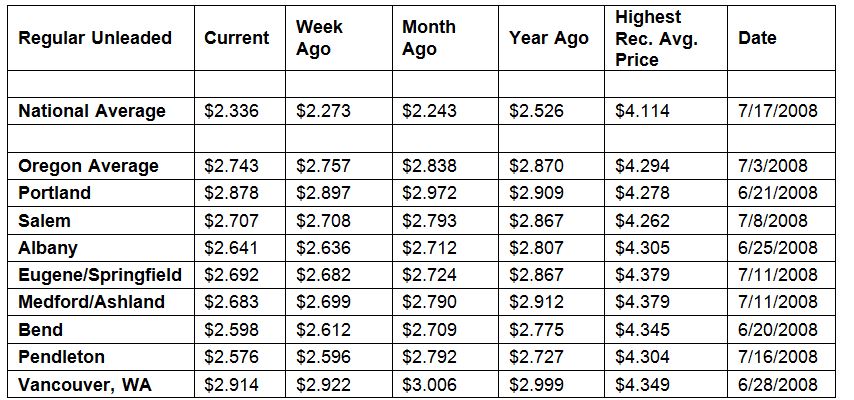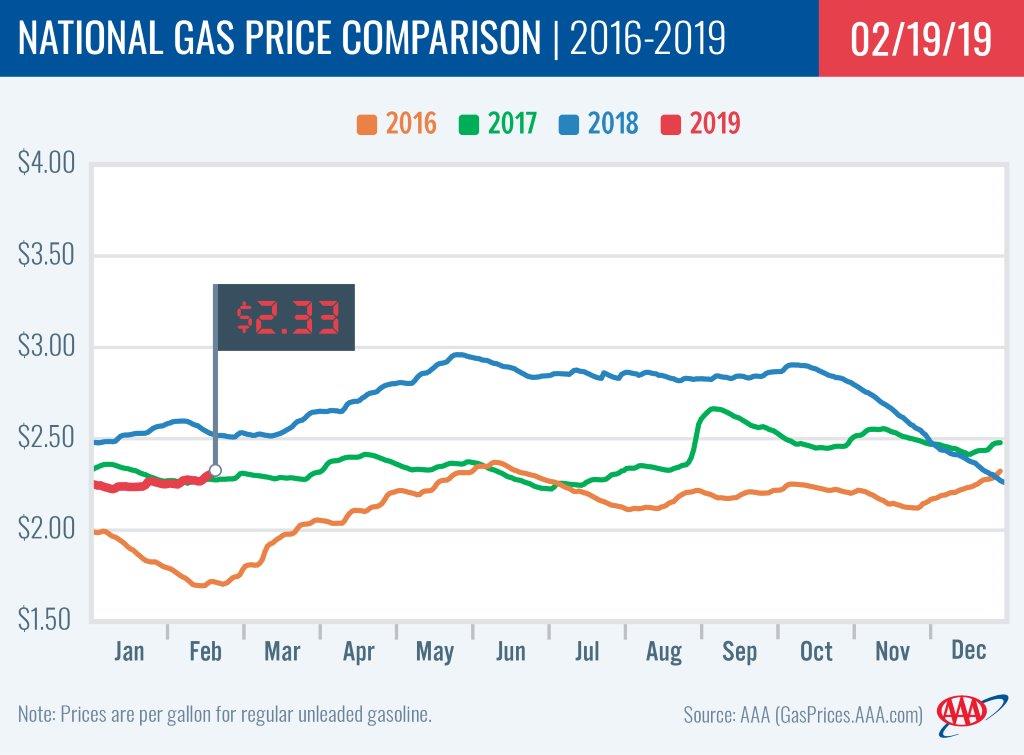28 states see pump prices climb by a nickel or more
PORTLAND, Ore., – Rising crude oil prices and continuing refinery issues are sending gas prices higher in most states but not Oregon. For the week, the national average shoots up six cents to $2.33 a gallon, the largest one-week increase for the national average this year. The Oregon average dips a penny to $2.74. The Oregon average is at its lowest price since May 2017.
Drivers in many parts of the country are seeing gas prices climb due to ongoing refinery problems coupled with crude oil prices rising to their highest levels of the year so far as global crude inventories tighten. “For now, Oregon pump prices continue to edge lower, but they will also start to rise soon,” says Marie Dodds, public affairs director for AAA Oregon/Idaho.
The latest Energy Information Administration (EIA) weekly report details demand dropping for a second week, to total at 8.6 million b/d. Frigid and severe winter weather in many parts of the country has been a driving factor for declining demand, and this week’s approaching storm from the Plains to the Northeast has the potential to drop demand further. Refinery problems and increasing exports have kept inventories at minimal builds. For the week ending Feb. 8, inventories increased only 408,000 bbl to total 258.3 million bbl.
Oregon is one of only 11 states where gas prices are lower week-over-week. Utah (-5 cents) has the largest drop. Michigan (+16 cents) and Oklahoma (+13 cents) have the largest weekly increases. In all, 28 states have seen pump prices climb by a nickel or more week-over-week. This week two states, California and Hawaii, have averages at or above $3 a gallon, same as a week ago.
Oregon is one of 17 states and the District of Columbia with lower prices now than a month ago. The national average is nine cents more and the Oregon average is 10 cents less than a month ago. This is the sixth-largest monthly drop in the nation. Utah (-23 cents) has the largest monthly decrease. Michigan (+36 cents) and Ohio (+25 cents) have the largest month-over-month increase.
The West Coast continues to have some of the most expensive gas prices in the nation with most of the region’s states landing on the top 10 most expensive list. California is most expensive, followed by Hawaii, Washington, Nevada, Alaska and Oregon rounding out the top six. Oregon is sixth most expensive for the seventh week in a row. Arizona ($2.42) is the only state in the region that dropped from the 10 most expensive markets list this week. Prices in the region have mostly declined on the week, with Arizona (-2 cents) seeing the largest drop.
| Rank | Region | Price on 2/19/19 | |
| 1 | California | $3.28 | |
| 2 | Hawaii | $3.26 | |
| 3 | Washington | $2.87 | |
| 4 | Nevada | $2.84 | |
| 5 | Alaska | $2.83 | |
| 6 | Oregon | $2.74 | |
| 7 | Pennsylvania | $2.57 | |
| 8 | District of Columbia | $2.52 | |
| 9 | New York | $2.48 | |
| 10 | Connecticut | $2.46 |
EIA’s recent weekly report showed that West Coast gasoline stocks decreased for a second week. They fell by approximately 500,000 bbl to 32.1 million bbl. Stocks are approximately 2.3 million bbl lower than at this time last year, which could cause prices to spike if there is a supply challenge in the region this week.
The nation’s cheapest markets are Alabama ($2.04) and Mississippi ($2.04). This week no states have an average below $2 compared to six states a week ago.
Oregon is one of 48 states and the District of Columbia where drivers are paying less than a year ago to fill up. The national average is 19 cents less and the Oregon average is 13 cents less than a year ago. North Dakota (-40 cents) has the greatest year-over-year decrease; Nevada (+6 cents) and Arizona (+5 cents) are the only two states with year-over-year increases.
Oil Market Dynamics
Oil prices continued to climb last week, due to growing belief that global supply is tightening. OPEC’s 1.2 million b/d production cut agreement, which is in effect for the first six months of 2019, has helped to rebalance the market. Also, an increasing reduction in crude exports from Venezuela due to U.S.-imposed sanctions has contributed to market observers believing the market will grow tighter in the coming weeks.
These factors will likely bolster crude prices even more this week, and market observers will look to this week’s EIA report to see if there are additional indicators of market tightening. As crude prices increase, American drivers can expect pump prices to follow suit, since approximately 50 percent of the cost consumers pay at the pump is due to the cost per barrel of crude oil.
Additionally, EIA reported that total domestic crude inventories grew by 3.6 million bbl to 450.8 million bbl last week. High crude production in the U.S., which held steady at a staggering 11.9 million b/d last week, contributed to the growth in crude stocks around the country and is expected to help meet global crude demand as supply challenges loom.
In related news, Baker Hughes Inc. reported that the U.S. added three oilrigs last week, bringing the total to 857. When compared to last year at this time, there are 59 more rigs this year.
At the close of Friday’s formal trading session on the NYMEX, WTI increased $1.18 to settle at $55.59 – the highest price point of the year. Markets were closed yesterday due to the President’s Day holiday. Today crude is trading around $56, compared to $54 a week ago. Crude prices are up about seven percent in the last month and are about $6 per barrel lower than a year ago.
Drivers can find current gas prices along their route with the free AAA Mobile app for iPhone, iPad and Android. The app can also be used to map a route, find discounts, book a hotel and access AAA roadside assistance. Learn more at AAA.com/mobile.
Diesel
For the week, the national average adds two cents to $2.94 a gallon. Oregon’s average slips a penny to $3.04. A year ago the national average for diesel was $2.97 and the Oregon average was $3.07.
Find current fuel prices at GasPrices.AAA.com.
AAA news releases, high resolution images, broadcast-quality video, fact sheets and podcasts are available on the AAA NewsRoom at NewsRoom.AAA.com.



